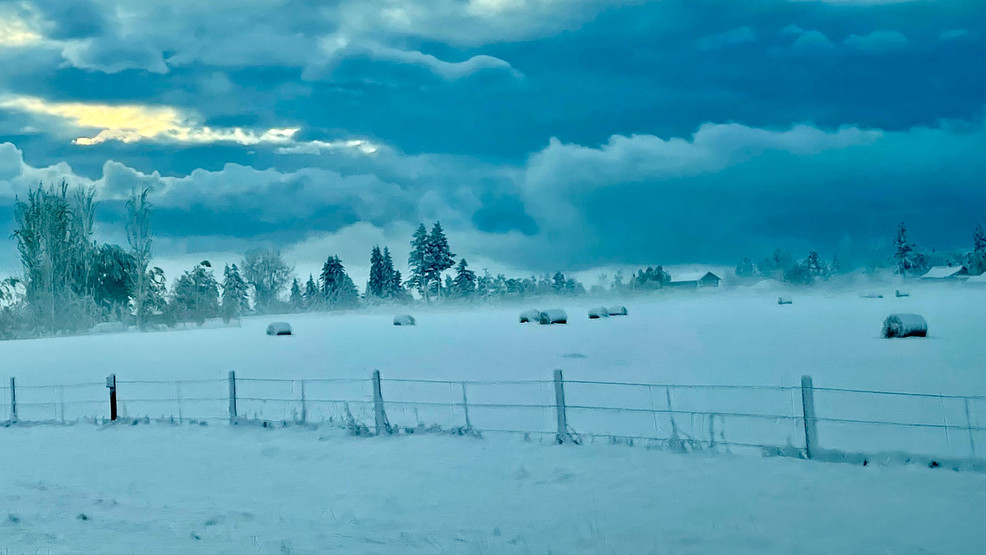What To Expect During A Wintry Mix Of Rain And Snow

Table of Contents
Understanding the Different Types of Precipitation in a Wintry Mix
A wintry mix isn't just one type of precipitation; it's a chaotic combination. Understanding the differences is key to knowing how to prepare and stay safe.
Rain
Rain, while seemingly harmless on its own, plays a significant role in a wintry mix. Its liquid form can lead to hazardous icy conditions when temperatures plummet below freezing.
- Potential Flooding: Rain can overwhelm drainage systems, leading to localized flooding, especially in low-lying areas.
- Reduced Visibility: Heavy rain significantly reduces visibility, making driving and walking dangerous.
- Washing Away Road Salt: Rain can wash away the salt applied to roads, reducing their effectiveness in preventing ice formation.
Freezing Rain
Freezing rain is arguably the most dangerous element of a wintry mix. This is liquid water that freezes instantly upon contact with any surface, creating a coating of clear ice.
- Extremely Hazardous Driving Conditions: Freezing rain creates incredibly slippery roads, making driving extremely hazardous and increasing the risk of accidents.
- Power Line Damage: The weight of ice accumulating on power lines can cause them to snap, resulting in widespread power outages.
- Tree Damage: The weight of ice can also cause significant damage to trees, resulting in downed branches and potential property damage.
Sleet
Sleet is frozen raindrops that bounce upon impact. While not as visually dramatic as freezing rain or snow, sleet can still cause significant problems.
- Reduced Visibility: Accumulating sleet can reduce visibility, making it challenging to navigate roads and sidewalks.
- Slippery Roads and Sidewalks: Sleet creates slippery surfaces, increasing the risk of falls and accidents.
- Accumulation on Power Lines: Sleet can accumulate on power lines, increasing the risk of power outages similar to freezing rain.
Snow
Snow is a common component of a wintry mix, and its accumulation depends on the temperature. In a wintry mix, the snow may be wet and heavy, or light and fluffy, depending on the temperature fluctuations.
- Reduced Visibility: Heavy snowfall significantly impairs visibility, leading to dangerous driving conditions.
- Slippery Roads: Snow makes roads and sidewalks slippery, increasing the risk of accidents and falls.
- Potential for Heavy Snowfall Accumulation: Depending on the duration and intensity of the snowfall, significant accumulation is possible, leading to further travel disruptions.
Preparing for a Wintry Mix
Proper preparation is crucial for mitigating the risks associated with a wintry mix. This preparation should encompass your home, vehicle, and personal safety.
Home Preparation
Taking preventative measures at home is critical in ensuring your safety and comfort during a wintry mix.
- Stock Up on Food and Water: Have a supply of non-perishable food and bottled water on hand in case of power outages.
- Have a Backup Power Source: Consider having a generator or battery backup for essential appliances and electronics.
- Check Heating System: Ensure your heating system is functioning correctly to maintain a comfortable indoor temperature.
- Prepare for Potential Power Outages: Have flashlights, candles, and extra blankets ready.
Vehicle Preparation
Your vehicle needs to be prepared for the challenges of driving in a wintry mix.
- Check Tire Pressure and Tread: Ensure your tires are properly inflated and have sufficient tread depth for optimal traction on icy roads.
- Have an Emergency Kit: Keep an emergency kit in your vehicle including jumper cables, blankets, a shovel, and an ice scraper.
- Fill Gas Tank: Keep your gas tank at least half full to avoid running out of fuel.
Personal Safety
Personal preparedness is as vital as home and vehicle preparation.
- Dress Warmly in Layers: Wear layers of clothing to trap body heat and stay warm.
- Wear Appropriate Footwear: Wear boots with good traction to prevent slips and falls on icy surfaces.
- Avoid Unnecessary Travel: Limit travel during the storm to essential trips only.
- Stay Informed About Weather Alerts: Monitor weather reports and heed warnings and advisories.
Driving in a Wintry Mix
Driving during a wintry mix requires extra caution and careful consideration.
Safety Tips
Driving in a wintry mix necessitates a change in driving habits to ensure safety.
- Reduce Speed: Significantly reduce your speed to allow for increased reaction time and better control.
- Increase Following Distance: Maintain a much greater following distance than you normally would to provide ample braking distance.
- Avoid Sudden Braking or Acceleration: Avoid any sudden maneuvers that could cause you to lose control.
- Use Headlights: Use your headlights even during the day to increase your visibility to other drivers.
- Be Aware of Black Ice: Black ice is nearly invisible and exceptionally dangerous; be extra cautious on bridges and overpasses where it's more likely to form.
When to Avoid Driving
Sometimes, the safest option is to stay off the roads altogether.
- During Periods of Heavy Snowfall: Avoid driving when visibility is severely reduced due to heavy snowfall.
- Freezing Rain: Freezing rain creates extremely dangerous driving conditions; it's best to avoid driving altogether.
- Reduced Visibility: If visibility is significantly reduced due to any type of precipitation, postpone your travel until conditions improve.
Emergency Preparedness
Even with careful preparation, accidents can happen.
- Pull Over to a Safe Location: If you encounter problems, pull over to a safe location away from traffic.
- Call for Help: Call emergency services immediately to report your situation.
- Stay in Your Vehicle if Possible: If you are stranded, stay in your vehicle for warmth and visibility.
Staying Informed During a Wintry Mix
Staying informed is critical during a wintry mix.
Reliable Weather Sources
Reliable sources are your lifeline for accurate information.
- Monitor Weather Forecasts: Continuously check weather forecasts from reputable sources, such as the National Weather Service or your local news.
- Heed Warnings and Advisories: Pay close attention to weather warnings and advisories and take appropriate action.
- Sign Up for Weather Alerts: Sign up for weather alerts via text, email, or a weather app to receive timely updates.
Emergency Alerts
Emergency alerts provide crucial information during severe weather.
- Sign Up for Emergency Alerts: Sign up for emergency alerts through your local government or emergency management agency.
Conclusion
A wintry mix presents significant challenges, but with proper preparation and awareness, you can significantly reduce the risks. Remember the key takeaways: understand the different types of precipitation, prepare your home and vehicle, drive cautiously (or not at all!), and stay informed. Stay safe this winter season! Share this guide with friends and family to help everyone prepare for the next wintry mix. Remember to be prepared and stay informed for safer navigation during a wintry mix.

Featured Posts
-
 Jose Mourinho Nun Dzeko Ve Tadic Ile Oynadigi Oyun
May 20, 2025
Jose Mourinho Nun Dzeko Ve Tadic Ile Oynadigi Oyun
May 20, 2025 -
 Le Passage De Marc Lievremont A Millau Un Recit Emouvant
May 20, 2025
Le Passage De Marc Lievremont A Millau Un Recit Emouvant
May 20, 2025 -
 Novini Pro Dzhennifer Lourens Aktrisa Stala Mamoyu Vdruge
May 20, 2025
Novini Pro Dzhennifer Lourens Aktrisa Stala Mamoyu Vdruge
May 20, 2025 -
 How To Dress For Breezy And Mild Conditions
May 20, 2025
How To Dress For Breezy And Mild Conditions
May 20, 2025 -
 Nvidia Ai
May 20, 2025
Nvidia Ai
May 20, 2025
Latest Posts
-
 Britains Got Talent Walliams And Cowells Feud Intensifies
May 20, 2025
Britains Got Talent Walliams And Cowells Feud Intensifies
May 20, 2025 -
 David Walliams Vs Simon Cowell Britains Got Talents Biggest Row Yet
May 20, 2025
David Walliams Vs Simon Cowell Britains Got Talents Biggest Row Yet
May 20, 2025 -
 David Walliams And Simon Cowell A Friendship Broken Celebrity News And Updates
May 20, 2025
David Walliams And Simon Cowell A Friendship Broken Celebrity News And Updates
May 20, 2025 -
 David Walliams And Simon Cowell Britains Got Talent Feud Explodes
May 20, 2025
David Walliams And Simon Cowell Britains Got Talent Feud Explodes
May 20, 2025 -
 Analyzing Bgts Blockbusters Special
May 20, 2025
Analyzing Bgts Blockbusters Special
May 20, 2025
